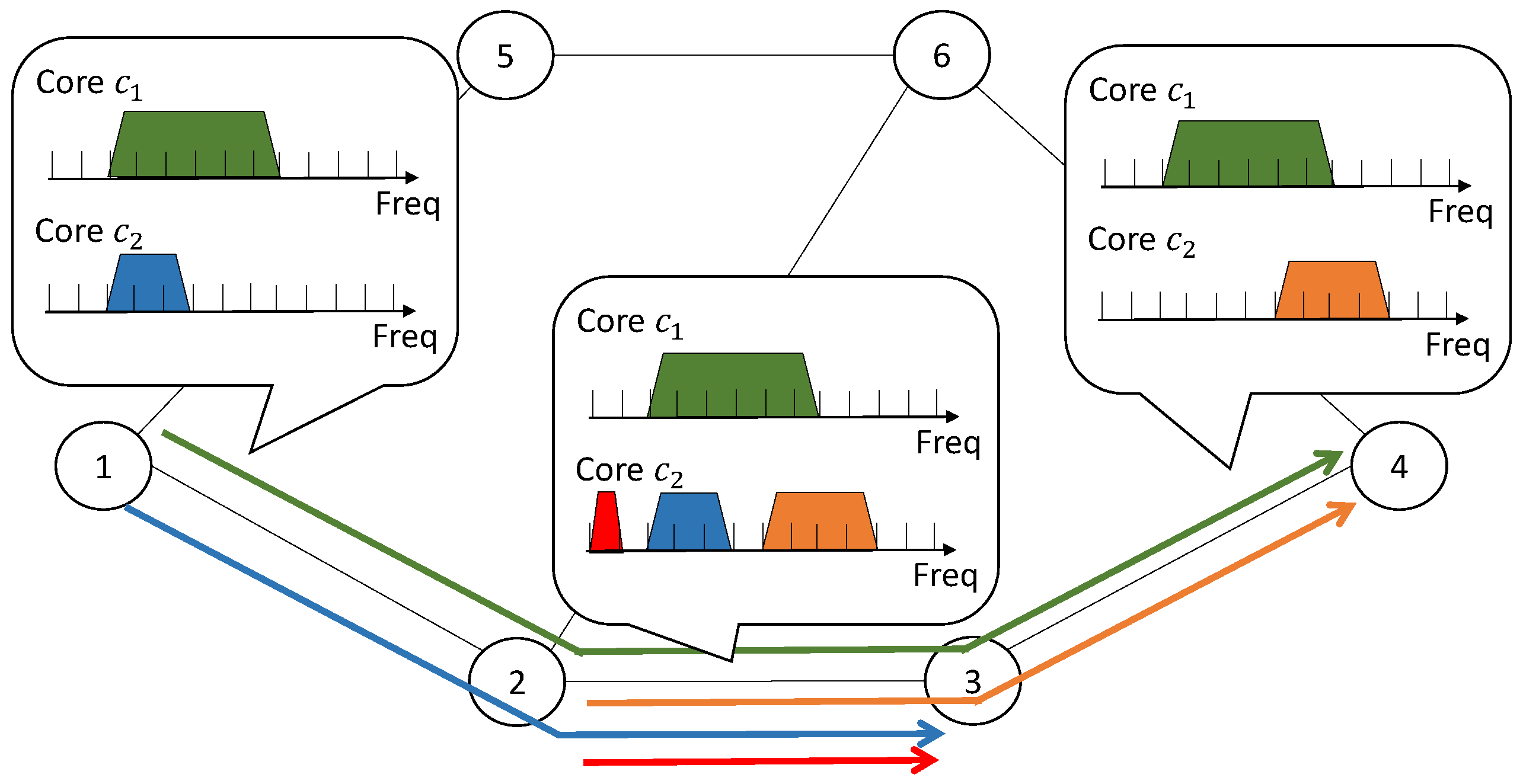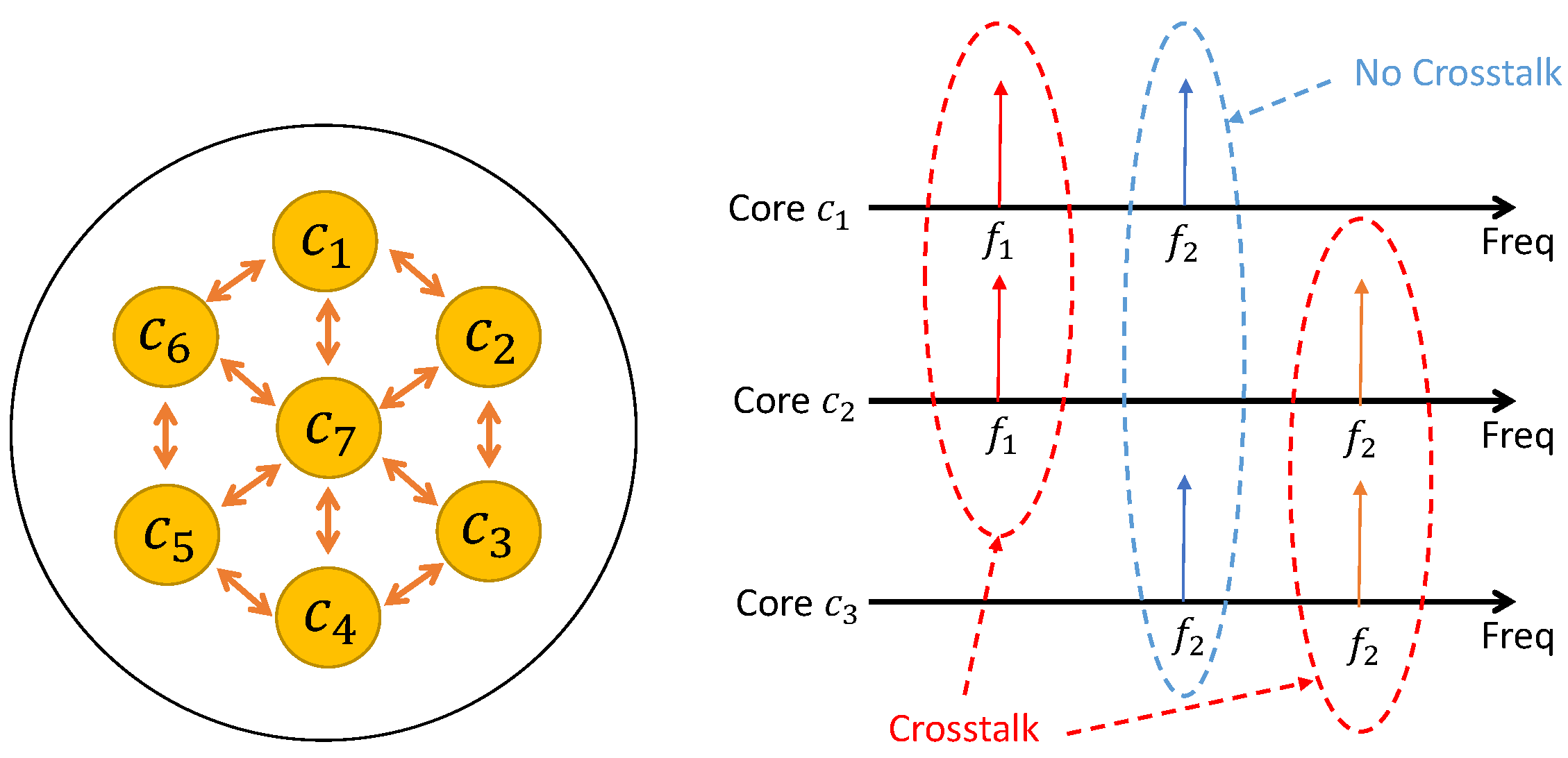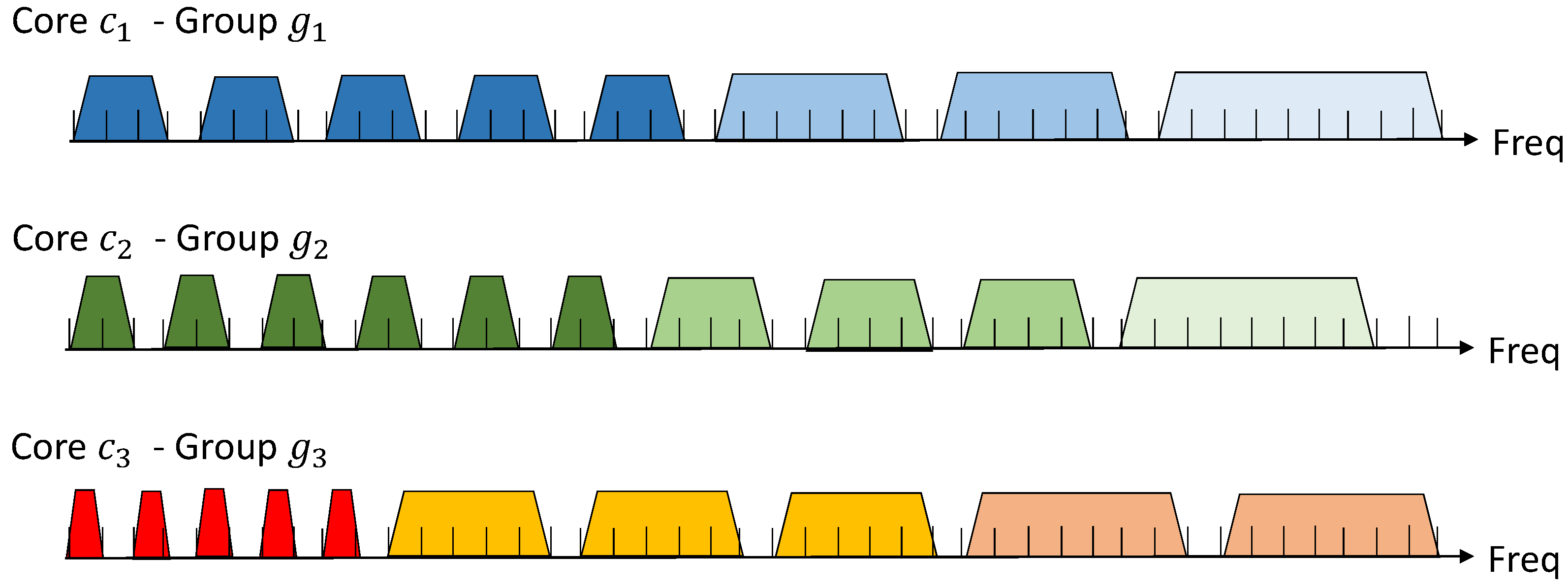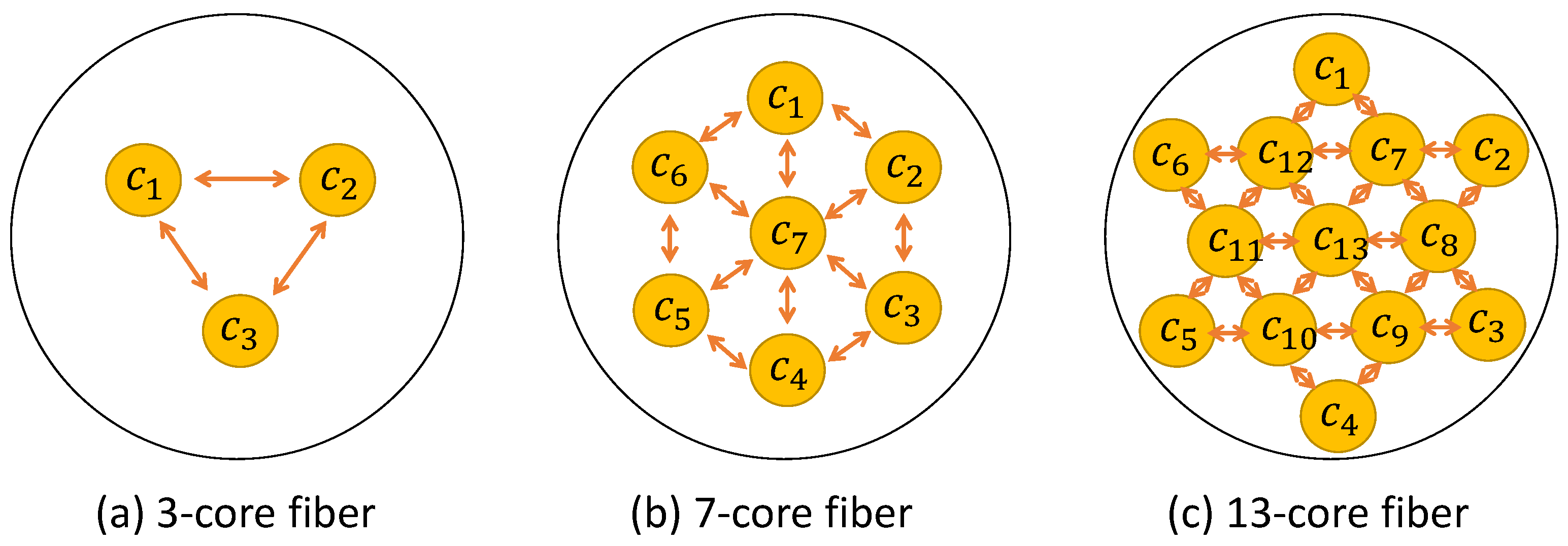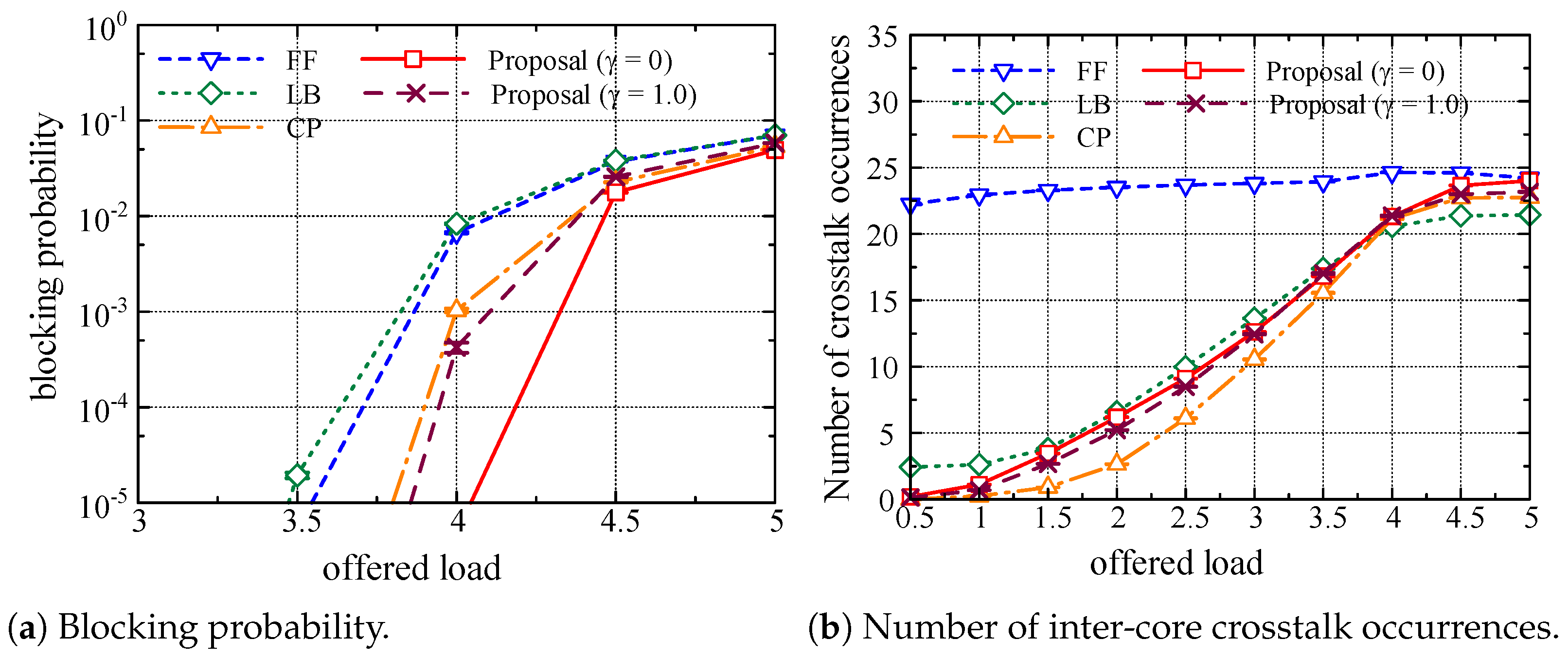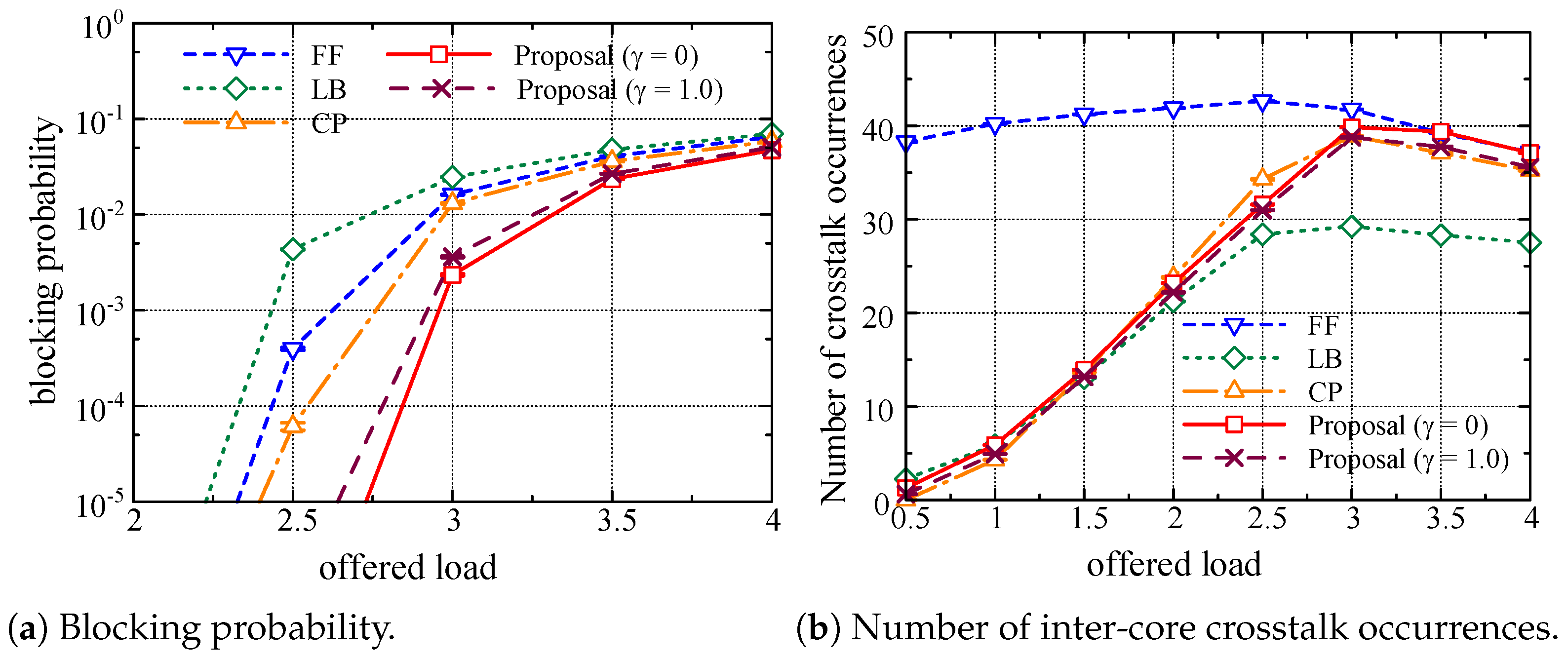5.2.1. Results for NSFNET
We first evaluated the performance of our proposed method in the NSFNET, as shown in
Figure 6a. The constant parameter
in the proposed method was set to 0 or
, unless stated otherwise. We defined the weight parameter
in the proposed method, as shown in
Table 6, which was obtained from a preliminary experiment. Note that the table indicates that
if
; otherwise,
. A similar logic was followed for other values of
.
In the preliminary experiments, we obtained the number
of successfully established lightpaths for each required number
of FSs when using only the shortest paths. We determined the FS range based on this value by treating it as the intended number of lightpaths requiring
FSs to be established, as mentioned in
Section 4.3. To achieve this, we calculated
, which represents the total number of frequency slots used for each
. Then, the calculated value was normalized by the sum of the values of
in the same group in such a way that the total became equal to the total number
of available FSs. The normalized result was used as the FS width to be assigned to each
. Accordingly, the prioritized FS range was determined, as discussed in
Section 4.3. By doing so, we expected to perform resource allocation that reflected both the required number of frequency slots and the number of lightpath requests generated, as illustrated in
Figure 4.
In the experiments, we used two performance metrics: the blocking probability of lightpath establishment and the average number of inter-core crosstalk occurrences between established lightpaths. We define the blocking probability of lightpath establishment as
Additionally, we define the average number of inter-core crosstalk occurrences between established lightpaths as
In this paper, we define the occurrence of inter-core crosstalk between established lightpaths as the case where identical FSs are used in adjacent cores by the lightpaths. In the experiments, we counted the number of inter-core crosstalk occurrences at each FS whenever a new lightpath was established, and we used their total sum as the denominator in (
12). The crosstalk level affecting the established lightpaths strongly depends on the number of inter-core crosstalk occurrences between the lightpaths. Note that we can calculate the crosstalk level using (
2), but it depends on specific parameters that vary with assumed environments. In this paper, to conduct the performance evaluation independent of the assumed environments, instead of calculating the crosstalk level using (
2), we employed the average number of inter-core crosstalk occurrences, defined in (
12), as the performance metric. This performance metric corresponds to the evaluation criteria used in related works, such as the CP method [
25] and other existing studies [
19,
20,
24].
We examined the performance of the proposed method in the scenario where the number
of cores in each fiber was small, i.e.,
.
Figure 7a shows the blocking probability of lightpath establishment as a function of the offered load
in NSFNET with
cores. Additionally,
Figure 7b shows the average number of inter-core crosstalk occurrences per lightpath establishment as a function of the offered load
in NSFNET with
cores. In
Figure 7a, we can observe that the blocking probability of the LB method was the highest. On the other hand, as shown in
Figure 7b, the average number of inter-core crosstalk occurrences in the LB method was the lowest. This is because the LB method avoids the use of the same FSs in adjacent cores. However, this strategy also leads to an increase in the blocking probability. The FF method decreases the blocking probability in contrast to the LB method. Meanwhile, the FF method increases the number of inter-core crosstalk occurrences because it does not take into account inter-core crosstalk occurrences during the FS allocation process.
In
Figure 7a, we can also observe that the blocking probabilities of the CP method and the proposed method with
were almost the same as that of the FF method. Furthermore, the proposed method with
exhibited the best performance in terms of the blocking probability. On the other hand, as shown in
Figure 7b, the number of inter-core crosstalk occurrences in the CP method and the proposed method with
was higher than that in the LB method. This result indicates that assigning priority to cores is ineffective in reducing crosstalk when all cores are adjacent to each other. The proposed method with
avoids the use of the same FSs in adjacent cores, similar to the LB method. Therefore, the number of inter-core crosstalk occurrences in the proposed method with
was close to that in the LB method, even though the number
of cores was small.
We then evaluated the performance of our proposed RCSA method when the number
of cores was increased, i.e.,
or 13.
Figure 8a,b show the blocking probability of lightpath establishment and the average number of inter-core crosstalk occurrences, respectively, as a function of the offered load
in NSFNET with
cores. As shown in
Figure 8a, the blocking probability of the LB method was the highest, similar to the result in
Figure 7a. In contrast, the CP method and the proposed method with
exhibited lower blocking probabilities than the FF method. The reason is that these methods suppress spectrum fragmentation by efficiently utilizing prioritized cores. We can also observe that the proposed method with
exhibited the best performance in terms of the blocking probability.
In
Figure 8b, we can observe that the FF method generated excessive inter-core crosstalk. On the other hand, the other methods efficiently reduced the number of inter-core crosstalk occurrences. The proposed method worked especially well when the offered load was small. This is because it selects cores so as to prevent inter-core crosstalk by appropriately setting the weight parameter
according to the required number
of FSs. We can also observe that the number of inter-core crosstalk occurrences was almost independent of the value of
in the proposed method. This result means that the impact of the weight parameter
becomes more significant as the number of cores increases.
Figure 9a,b show the blocking probability of lightpath establishment and the average number of inter-core crosstalk occurrences, respectively, as a function of the offered load
in NSFNET with
cores. In these figures, we can observe that the proposed method with
achieved the best performance in terms of the blocking probability, similar to the previous results. On the other hand, the number of inter-core crosstalk occurrences in the proposed method was slightly larger than that in the CP method. The CP method tended to use cores with assigned priorities in order, preventing inter-core crosstalk. Therefore, as the number of cores increased, the crosstalk reduction effect became more significant. On the other hand, the proposed method focused on reducing the blocking probability by flexibly determining the cores to be used based on the weight parameters, even though some inter-core crosstalk occurred. However, the amount of inter-core crosstalk can be considered sufficiently small in this case. Note that with an appropriate choice of the weight parameters, the proposed method is expected to achieve performance comparable to that of the CP method.
Figure 10a,b show the blocking probability of lightpath establishment and the average number of inter-core crosstalk occurrences, respectively, as a function of the value of
in the proposed method in NSFNET. As shown in
Figure 10a, the blocking probability increased with the value of
, regardless of the number
of cores. In contrast, the number of inter-core crosstalk occurrences decreased with the increase in the value of
.
There exists a trade-off between the blocking probability and the number of inter-core crosstalk occurrences with respect to the value of . Therefore, it is important to decrease the value of to ensure that any arbitrary crosstalk threshold can be satisfied, taking this trade-off into account. If the crosstalk level is sufficiently low, selecting yields the best performance, as it minimizes the blocking probability of lightpath establishment. The acceptable crosstalk level depends on the assumed environments; thus, we need to select the appropriate value of accordingly. A detailed discussion on the relationship between the value of and the crosstalk threshold is left for future work.
5.2.2. Results for USA Network
We then examined the performance of our proposed RCSA method in the USA network shown in
Figure 6b. Here, we defined the weight parameter
in the proposed method, as shown in
Table 7.
Figure 11a,b show the blocking probability of lightpath establishment and the average number of inter-core crosstalk occurrences, respectively, as a function of the offered load
in the USA network with
cores. In these figures, we can observe characteristics similar to the results for NSFNET with
cores, as shown in
Figure 7. Specifically, the proposed method with
achieved the lowest blocking probability, and the proposed method with
reduced the number of inter-core crosstalk occurrences more efficiently than the proposed method with
when the number of cores
was small.
Figure 12a,b show the blocking probability of lightpath establishment and the average number of inter-core crosstalk occurrences, respectively, as a function of the offered load
in the USA network with
cores. As we can see in these figures, when the offered load
was larger than 2.5, the number of inter-core crosstalk occurrences in the LB method was the lowest, but the blocking probability was too high, which is not acceptable. On the other hand, the blocking probabilities of the proposed method with
and
were too low. Furthermore, our proposed method efficiently reduced the number of inter-core crosstalk occurrences when the offered load
was small.
Figure 13a,b show the blocking probability of lightpath establishment and the average number of inter-core crosstalk occurrences, respectively, as a function of the offered load
in the USA network with
cores. As shown in these figures, the proposed method with
and
efficiently reduced the blocking probability of lightpath establishment, similar to the result shown in
Figure 12a. Moreover, we can also observe that it maintained a low level of inter-core crosstalk. Since the OSNR can be ensured by keeping the inter-core crosstalk below a certain threshold, the proposed method, which minimizes the blocking probability of lightpath establishment while keeping the number of inter-core crosstalk occurrences low, can be considered the most effective approach.
